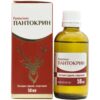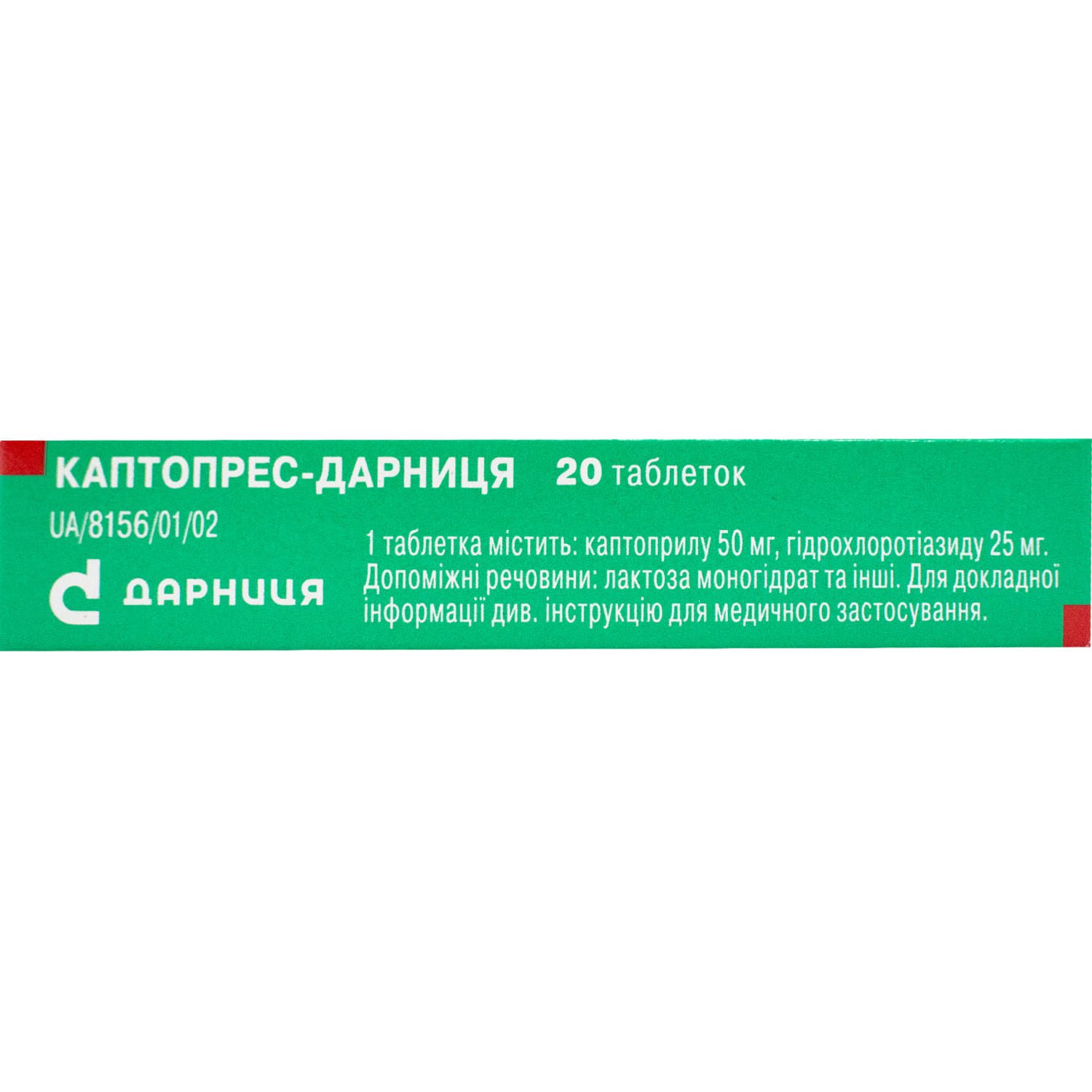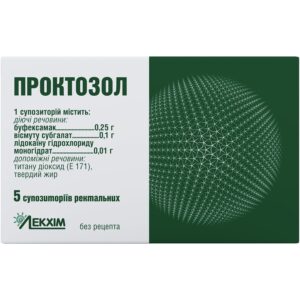Pharmacological properties
Pharmacodynamic parameters. Captopril is a specific competitive inhibitor of ACE, which is responsible for the transformation of angiotensin I into angiotensin II (the latter is a regulator of blood pressure and a key component of the renin-angiotensin-aldosterone system).
The affinity of captopril for ACE is approximately 30,000 times higher than that of angiotensin I. A decrease in the content of angiotensin II in the body and, accordingly, the severity of its pressor effects, leads to a decrease in blood pressure.
Due to the relative absence of negative feedback on renin release caused by the decrease in angiotensin II, plasma renin activity increases.
The content of aldosterone in the blood and urine decreases (and, as a result, the level of potassium in the blood serum increases slightly, along with the excretion of sodium and fluid from the body).
The thiazide diuretic hydrochlorothiazide inhibits water reabsorption in the distal convoluted tubules of the nephron. Administration of hydrochlorothiazide leads to increased excretion of sodium and chloride (in approximately equivalent amounts) and secondary loss of potassium and bicarbonate.
Normal blood pressure values do not change when taking hydrochlorothiazide.
Pharmacokinetic parameters
Captopril. Rapidly absorbed in the gastrointestinal tract (with food intake, the absorption rate decreases by 30-40%). 70-75% of the orally administered dose is absorbed, bioavailability is about 65%. C max in the blood is reached 45-60 minutes after administration. Captopril contains sulfhydryl groups and easily binds to albumin and other blood plasma proteins. T ½ of unchanged captopril is about 2 hours. The main route of excretion is with urine (within 24 hours 95% of the dose taken). Renal clearance of unchanged captopril exceeds the glomerular filtration rate due to active tubular secretion of the drug.
Hydrochlorothiazide. Rapidly absorbed from the gastrointestinal tract, bioavailability is 68-78%. C max in the blood is reached 1-2 hours after administration. About 58% binds to plasma proteins. T ½ ≈3-4 h (increases in patients with CHF and renal failure). Rapidly excreted by the kidneys (20-75% of the unchanged dose).
Indication
Hypertension.
Application
Orally 1 hour before meals once a day. The dose is selected individually.
Starting dose (including patients with creatinine clearance 30-80 ml/min): 25 mg captopril + 12.5 mg. If necessary, the dose is increased to 50 mg captopril + 25 mg hydrochlorothiazide. If the patient’s condition does not require a rapid change in dose, it is adjusted at intervals of 6 weeks.
Contraindication
- Hypersensitivity to captopril (and other ACE inhibitors), hydrochlorothiazide (and other sulfonamides) or other components of the drug; congenital angioedema (or a history of it against the background of therapy with other ACE inhibitors); severe liver function disorders (hepatic precoma and coma); creatinine clearance 30 ml/min; condition after nephrotransplantation; anuria; bilateral stenosis of the aa. renalis.
(Or stenosis of the artery of a single kidney with progressive azotemia);
- porphyria;
- narrowing of the aortic orifice (or other obstructive disorders that prevent the outflow of blood from the left ventricle;
- primary hyperaldosteronism, hypokalemia, hyponatremia in hypovolemia, hypercalcemia, gout.
Side effects
When taking captopril:
- pallor, decreased blood pressure (90/60 mm Hg), postural hypotension, Raynaud’s syndrome, angina pectoris, hot flashes, increased heart rate (90 beats/min), tachyarrhythmia, rapid heartbeat, cardiogenic shock, cardiac arrest;
- nonproductive cough, bronchospasm, dyspnea, rhinitis, laryngitis, allergic alveolitis/eosinophilic pneumonia;
- dry mouth, nausea, vomiting, constipation, diarrhea, epigastric discomfort, abdominal pain, stomatitis/aphthous ulcers, glossitis, peptic ulcer, pancreatitis;
- liver dysfunction and cholestasis, hepatitis, increased bilirubin levels, liver enzyme activity;
- decreased renal function (including renal failure), proteinuria, polyuria, pollakiuria, oliguria, nephrotic syndrome;
- anorexia, hypoglycemia, decreased blood sodium levels, increased blood potassium levels;
- dysgeusia, drowsiness, headache, dizziness, paresthesia, cerebral circulation disorders;
- depression, sleep disturbances, confusion;
- blurred vision;
- eosinophilia, pancytopenia, decreased platelet count (150 x 10 9 / l), anemia, decreased white blood cell count (4⋅10 9 / l), decreased neutrophil content (1000 / ml 3) /agranulocytosis;
- pruritus (with or without rash), alopecia, angioedema, peripheral edema, urticaria, erythema multiforme, Stevens-Johnson syndrome, photosensitivity reactions, erythroderma, pemphigoid reactions, exfoliative dermatitis, autoimmune disorders, fever;
- pain in muscles and joints;
- erectile dysfunction, gynecomastia;
- lymphadenopathy, fatigue, weakness;
- increased blood plasma creatinine and urea levels, increased ESR, decreased hematocrit and hemoglobin levels, increased antinuclear antibody levels, false-positive urine acetone test.
When taking hydrochlorothiazide:
- orthostatic hypotension, cardiac arrhythmias; necrotizing vasculitis;
- respiratory disorders;
- sialoadenitis, decreased appetite, thirst, dry mouth, nausea, vomiting, stomach irritation, diarrhea, constipation, pancreatitis;
- jaundice, cholecystitis;
- deterioration of renal function, interstitial nephritis;
- anorexia, hyperglycemia, glucosuria, decreased glucose tolerance, hyperuricemia, electrolyte imbalance (including hypochloremic alkalosis); acidosis; decreased blood sodium, potassium, magnesium, increased blood calcium, increased cholesterol and triglyceride levels;
- drowsiness, headache, paresthesia, seizures, dizziness, vertigo;
- sleep disturbances, mood changes, depression, nervousness, anxiety, disorientation, confusion;
- transient blurred vision, acute myopia, xanthopsia, glaucoma (acute angle-closure);
- decrease in the number of leukocytes (4⋅10 9 / l), neutropenia / agranulocytosis, decreased platelet count (150⋅10 9 / l), anemia (aplastic, hemolytic), bone marrow dysfunction;
- urticaria, anaphylactic reactions, anaphylactic shock;
- photosensitivity reactions, rash, eczema, lupus-like syndrome, reactivation of cutaneous lupus erythematosus, purpura, Lyell’s syndrome, Stevens-Johnson syndrome;
- muscle pain, muscle spasm;
- sexual disorders;
- fever, weakness, exhaustion.
Special instructions
Captopril/hydrochlorothiazide.
Do not combine with alcohol.
During therapy, it is recommended to monitor the peripheral blood picture, the content of electrolytes, creatinine and urea in blood plasma; a diet with sodium restriction.
Use with caution in patients with fluid and electrolyte imbalances or on hemodialysis.
In patients over the age of 65, as well as with severe cardiovascular disorders, careful monitoring of fluid and electrolyte levels in the body, blood pressure, and kidney function is mandatory.
Before starting treatment, it is necessary to reduce or stop taking diuretics and correct fluid and electrolyte levels.
Hydrochlorothiazide: Caution is required when used in patients with impaired liver function or progressive liver disease (careful monitoring of blood pressure, renal function, fluid and electrolyte levels is necessary).
Given the likelihood of developing azotemia during thiazide therapy, careful assessment of its feasibility (with possible discontinuation) is necessary in the event of progression of renal pathology.
The antihypertensive effect may be enhanced in patients who have undergone sympathectomy.
In case of development of sensitivity reactions to sunlight, it is necessary to discontinue the drug or protect exposed areas of the body from insolation or UV radiation.
Perhaps:
- decrease in blood potassium and sodium levels, development of hypochloremic alkalosis;
- increased calcium levels in the blood;
- increased cholesterol and triglyceride levels, decreased magnesium and thyroglobulin levels in blood plasma.
Gout may worsen (as a result of increased uric acid levels).
May be the cause of positive doping test results.
Captopril. In patients with renal pathology, an increase in the content of creatinine and urea in the blood plasma is possible. If renal function decreases, it is necessary to reduce the dose of captopril and / or cancel the use of the diuretic.
Proteinuria may occur in patients with reduced renal function or when using captopril at a dose of 150 mg/day.
Monitoring of protein in the urine is required in case of decreased renal function during drug therapy.
In patients with impaired renal function, diabetes mellitus, as well as when taking potassium-sparing diuretics, potassium-containing dietary supplements or salt substitutes, drugs that increase the level of potassium in the blood plasma, the use of ACE inhibitors increases the risk of hyperkalemia.
When using ACE inhibitors, an unproductive cough may occur.
In case of uncomplicated hypertension, arterial hypotension may develop. The probability of this event increases in patients with heart failure, receiving hemodialysis, or with impaired fluid and electrolyte balance in the body. In this category of patients, as well as in patients with coronary artery disease or with cerebral vascular pathology, renovascular hypertension, initial therapy under the supervision of a physician with the use of low, carefully selected doses is necessary.
The drug must be discontinued in the following cases:
- development of cardiogenic shock and significant hemodynamic disturbances;
- the appearance of jaundice or a pronounced increase in the activity of liver enzymes;
- development of Quincke’s edema (hospitalization and appropriate therapy with supervision for 12-24 hours is indicated until the symptoms disappear completely).
Caution should be exercised when using the drug:
- in patients with diabetes mellitus receiving insulin or oral hypoglycemic agents (regular monitoring of blood glucose levels is necessary);
- in patients with collagen diseases who are treated with immunosuppressants, who are taking allopurinol or procainamide (as well as in the case of a combination of these conditions), especially against the background of existing renal dysfunction (periodic monitoring of the number of leukocytes in the blood plasma and vigilance for any signs of infection are necessary; in case of neutropenia, the drug is canceled).
If hypotension occurs during the use of captopril in patients undergoing surgery or anesthesia with drugs that lower blood pressure, correction is carried out by administering additional fluid volume.
In patients receiving ACE inhibitors, persistent anaphylactic reactions may develop:
- during desensitization with hymenoptera venom (precautionary measure – temporary withdrawal of ACE inhibitors);
- during hemodialysis using high-flux membranes (precautionary measure – replacing dialysis membranes with membranes of a different type, or switching to antihypertensive drugs of a different class);
- during LDL apheresis (precautionary measure – temporary discontinuation of ACE inhibitors before each apheresis).
Cross-hypersensitivity may occur with ACE inhibitors.
Given the lactose content in the drug, its use is contraindicated in patients with lactase deficiency, galactosemia, or impaired absorption of glucose or galactose in the gastrointestinal tract.
The drug is not taken during pregnancy and breastfeeding.
There is no information on the use of the drug in children.
While taking the drug, it is necessary to refrain from activities that require increased concentration and speed of psychomotor reactions (including driving a vehicle and working with other mechanisms).
Interactions
captopril
Enhances CNS depression when taken simultaneously with alcohol.
Enhances the hypoglycemic effect of oral hypoglycemic agents.
Enhances the possible decrease in blood pressure when using anesthetics.
Reduces the manifestations of secondary hyperaldosteronism and hypokalemia due to the use of diuretics.
Increased plasma levels of digoxin and lithium preparations.
The hypotensive effect is enhanced by simultaneous use with ethanol, other antihypertensive or diuretic agents, antipsychotics, clonidine, and narcotic analgesics.
The hypotensive effect is weakened when taken simultaneously with antacids, estrogens, sympathomimetics, and NSAIDs.
Concomitant use with cyclosporine, potassium-sparing diuretics, potassium-containing dietary supplements or salt substitutes increases the risk of developing hyperkalemia.
The risk of neutropenia and/or agranulocytosis increases with the simultaneous use of captopril with immunosuppressants, cytostatics and/or allopurinol.
Renal excretion of captopril is slowed by concomitant use with probenecid.
Hydrochlorothiazide
Concomitant use of alcohol, barbiturates, or narcotics may potentiate orthostatic hypotension.
In case of combined use with antidiabetic drugs, their dose should be adjusted.
In case of simultaneous use with other antihypertensive drugs – additive effect or potentiation of action.
The absorption of hydrochlorothiazide is sharply reduced when cholestyramine or colestipol are used (by 85 and 43%, respectively).
Simultaneous use with corticosteroids and ACTH leads to electrolyte balance disorders and severe hypokalemia.
There may be a decrease in the response to pressor amines.
Increased sensitivity to non-polarizing muscle relaxants is possible.
Concomitant use with NSAIDs may reduce the diuretic effect.
Simultaneous administration with lithium preparations (due to a decrease in its renal clearance) increases the risk of toxic effects of these drugs.
Overdose
Captopril. Overdose is manifested by headache, increased heart rate (90 beats / min), severe arterial hypotension, decreased appetite, dysgeusia, development of skin allergic reactions, agranulocytosis. In rare cases, arrhythmia, decreased heart rate (40 beats / min), paresis, convulsions, stupor, shock, renal failure, fluid and electrolyte balance disorders in the body are possible.
Therapy is symptomatic.
Hydrochlorothiazide. Overdose is manifested by diarrhea, nausea, vomiting, weakness. It is possible to develop paresthesias, muscle spasms, dizziness, hypotension, increased heart rate (90 beats / min), shock, impaired consciousness, cachexia, poly-, oligo-, anuria, decreased blood potassium, sodium, chlorine, alkalosis. In patients with renal insufficiency – increased blood urea nitrogen. In severe cases – a pronounced disorder of fluid and electrolyte balance in the body, coma.
Overdose therapy: artificially induced vomiting; gastric lavage, sorbents. Severe cases require intensive detoxification (hemodialysis), normalization of vital functions, fluid and electrolyte balance in the body, restoration of renal function.
Storage conditions
At a temperature ≤25 °C in the original packaging.











Reviews
There are no reviews yet.